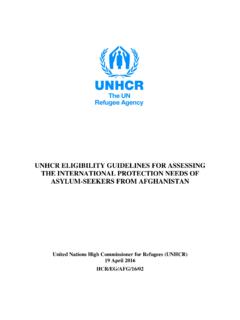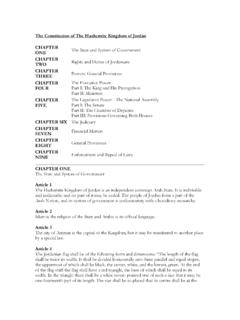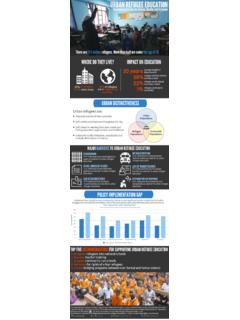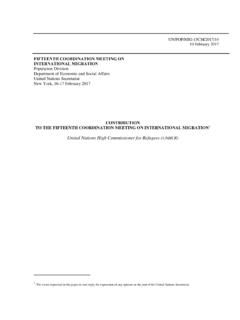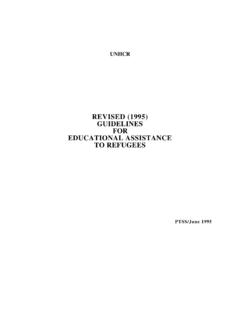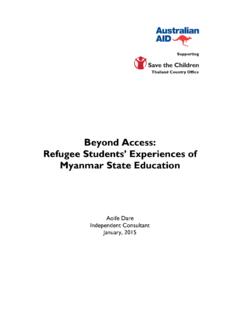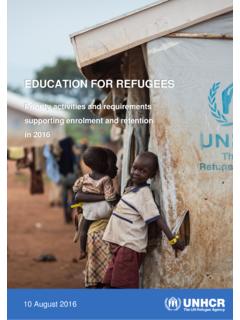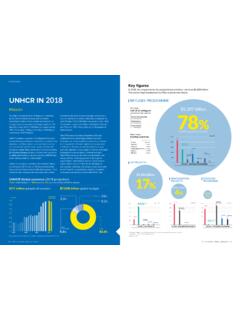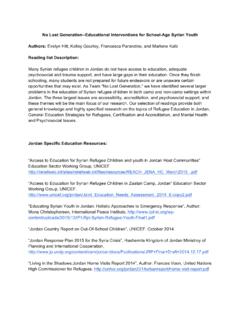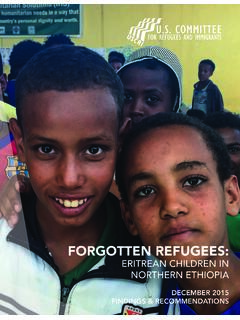Transcription of The Situation of Palestinian Refugees in Lebanon - …
1 1 The Situation of Palestinian Refugees in Lebanon February 2016 This document provides information about the Situation of Palestine Refugees in Lebanon , including non-registered Palestinian Refugees , undocumented ( non-ID ) palestinians , and Palestine Refugees from Syria, including the human rights and humanitarian Situation and limitations in relation to Refugees access to basic services and livelihoods, based on information provided by UNRWA and other available sources. This document is based on information available up to 23 February 2016.
2 I. INTRODUCTION .. 2 II. PALESTINE Refugees .. 4 1. Legal Status .. 4 2. Freedom of 4 3. Travelling in and out of Lebanon .. 5 4. Access to Services .. 5 a. Access to Employment and Livelihoods .. 5 b. Property and Housing .. 6 c. Access to Healthcare .. 8 d. Access to Education .. 9 e. Women and Children .. 9 f. Palestine Refugees with Specific Vulnerabilities .. 10 III. NON-REGISTERED palestinians .. 10 IV. NON-ID palestinians .. 10 V. PALESTINE Refugees FROM SYRIA IN Lebanon .. 12 1. Access to Territory .. 12 2. Legal Status .. 13 3. Civil Registration and Access to Documentation.
3 14 4. Restrictions on Freedom of Movement, Risk of Detention and Deportation .. 15 5. Access to Services .. 15 a. Overview .. 15 b. Access to Employment and Livelihoods .. 16 c. Housing .. 16 d. Access to Healthcare .. 17 e. Access to Education .. 17 VI. PALESTINE REFUGEE CAMPS .. 17 1. Security Conditions .. 17 2. Arbitrary Arrest and Detention .. 18 3. Palestinian Individuals in Conflict with Armed Factions .. 19 4. Nahr El-Bared Camp .. 19 5. Rashidieh Camp .. 21 6. Shatila Camp .. 21 7. Ein El-Hilweh 22 2I. INTRODUCTION Based on their legal status and registration with the United Nations Relief and Works Agency for Palestine Refugees in the Near East (UNRWA), Palestinian Refugees in Lebanon can be categorized into four groups: Registered Refugees ( Palestine Refugees ), which are registered with UNRWA and the Lebanese authorities; Non-registered Palestinian Refugees , which are not registered with UNRWA, but are registered with the Lebanese authorities.
4 Non-ID Palestinian Refugees , who are neither registered with UNRWA nor with the Lebanese authorities;1 and Palestine Refugees from Syria, who have arrived in Lebanon since There are currently over 504,000 Palestine Refugees registered by UNRWA in However, it is estimated that many are no longer present in the country. According to a (yet unpublished) study conducted by the American University in Beirut in 2015, between 260,000 and 280,000 Palestine Refugees currently remain in Palestine Refugees in Lebanon reportedly continue to face acute socioeconomic deprivation and legal barriers to their full enjoyment of a broad range of human rights.
5 Palestine Refugees in Lebanon are reported to have historically been marginalized and excluded from key aspects of social, political and economic life with no right to own immovable property; severely curtailed access to public services (other than those provided by UNRWA), such as health and education; and restrictions regarding specific professions and limited job Despite the 1987 abrogation of the 1969 Cairo Agreement6 between the Palestinian leadership and the Lebanese government, which stipulated that the Lebanese army would refrain from entering the Palestine refugee camps, the army generally does not exercise control in the camps.
6 Palestine refugee camps are thus controlled by Palestinian factions, with different camps often ruled by competing The camps are reported to be generally 1 Aidoun, Undocumented palestinians in Lebanon (Non-ID Refugees ), 2014, [hereafter: Aidoun, Undocumented palestinians in Lebanon , 2014], pp. 2-3; Danish Refugee Council (DRC), Survey Report on the Situation of Non-ID Palestinian Refugees Lebanon , September 2007, [hereafter: DRC, Situation of Non-ID Palestinian Refugees Lebanon , September 2007], pp.
7 16-17. 2 For information on the Situation of Palestine/ Palestinian Refugees in Syria, see UN High Commissioner for Refugees (UNHCR), International Protection Considerations with regard to People Fleeing the Syrian Arab Republic, Update IV, November 2015, , paras 21-22. 3 United Nations Relief and Works Agency for Palestine Refugees in the Near East (UNRWA), registration numbers as at January 2016. 4 American University of Beirut (AUB), Socio-Economic Survey of Palestine Refugees in Lebanon , 2015 (to be published).
8 See also, United States Department of State, 2014 Report on International Religious Freedom - Lebanon , 14 October 2015, ; International Crisis Group (ICG), Nurturing Instability: Lebanon 's Palestinian Refugee Camps, Middle East Report N 84, 19 February 2009, [hereafter; ICG, Lebanon 's Palestinian Refugee Camps, 19 February 2009]. 5 AUB, Socio-Economic Survey of Palestinian Refugees in Lebanon , 31 December 2010, , Chapter 1. 6 The 1969 Cairo Accord is available at: ICG, Lebanon 's Palestinian Refugee Camps, 19 February 2009, Appendix C.
9 7 Government security forces reported to civilian authorities, although (..) Palestinian security and militia forces, (..) operated outside the direction or control of government officials. (..) Palestinian refugee camps continued to act as self-governed entities and maintained security and militia forces not under the direction of government officials ; US Department of State, 2014 Country Reports on Human Rights Practices - Lebanon , 25 June 2015, See also, Al Jazeera, palestinians Desperate to Flee Lebanon Refugee Camp, 5 April 2015, ; Haaretz, palestinians in Mideast Find Their Position More Precarious in Wake of Syria War, 27 March 2015.
10 Sari Hanafi, Palestinian Refugee Camps in Lebanon : Laboratories of State-in-the-Making, Discipline and Islamist Radicalism, in: Ronit Lentin, Thinking Palestine. London: Zed Books (2008): 82-100, p. 90, For an overview of different factions, see also, Nicolas Dot-Pouillard, Between Radicalization and Mediation Processes: A Political Mapping of Palestinian Refugee Camps in Lebanon , Civil Society Knowledge Center, Lebanon Support, October 2015, [hereafter: Nicolas Dot-Pouillard, A Political Mapping of Palestinian Refugee Camps in Lebanon , October 2015]; ICG, Lebanon 's Palestinian Refugee Camps, 19 February 2009, p.
